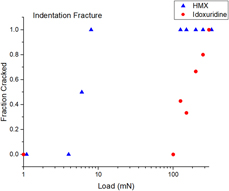Article contents
Indentation fracture behavior of energetic and inert molecular crystals
Published online by Cambridge University Press: 22 November 2019
Abstract

Measuring the elastic and plastic properties with nanoindentation is predicated on the indentation not fracturing the material. In this study, an unloading curve analysis is used to identify indentation-induced fracture in brittle molecular organic crystals to define conditions, where properties measurements are accurate, and for calculating the toughness. Single crystals of cyclotetramethylene tetranitramine (HMX) and idoxuridine were indented from 1 to 300 mN with indenter probes of varying acuity to identify fracture initiation loads. Idoxuridine displayed no fracture up to and at 100 mN, with fracture occurrence then seen at an increasing rate until every indentation made induced fracture at 300 mN. HMX displayed no fracture up to and at 4 mN, with fracture then occurring at an increasing rate until every sample fractured at 8 mN. The toughness of HMX and idoxuridine is ≈0.28 ≈ 0.4–0.5 MPa/m1/2, respectively.
Keywords
- Type
- Article
- Information
- Copyright
- Copyright © Materials Research Society 2019
References
- 9
- Cited by




